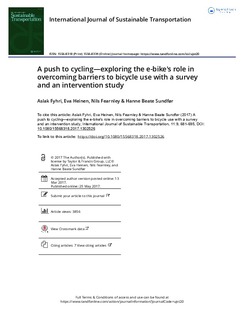| dc.contributor.author | Fyhri, Aslak | |
| dc.contributor.author | Heinen, Eva | |
| dc.contributor.author | Fearnley, Nils | |
| dc.contributor.author | Sundfør, Hanne Beate | |
| dc.coverage.spatial | Norway | nb_NO |
| dc.date.accessioned | 2019-12-17T11:16:57Z | |
| dc.date.available | 2019-12-17T11:16:57Z | |
| dc.date.created | 2017-05-16T13:56:35Z | |
| dc.date.issued | 2017-03-13 | |
| dc.identifier.citation | International Journal of Sustainable Transportation. 2017, 11 (9), 681-695. | nb_NO |
| dc.identifier.issn | 1556-8318 | |
| dc.identifier.uri | http://hdl.handle.net/11250/2633608 | |
| dc.description.abstract | In Norway, as in many countries, there is a political goal to increase bicycle use. The electric bicycle (e-bike) is a promising tool for achieving this goal, given the hilliness of the country. However, little is yet known about the deterrents of cycling in Norway in general, and in particular how the purchase of an e-bike could be stimulated. In the current study, 5500 respondents from a convenience sample among car owners were asked about their perceptions of bicycling in general, and of e-bikes in particular as well as their willingness to pay (WTP) for an e-bike. Randomly selected participants (N = 66) were given access to an e-bike for a limited time (2 or 4 weeks). A second questionnaire captured the same perceptions and WTP post-intervention. The results were compared with a control group (N = 214). The results showed that those who cycle the least were most interested in buying an e-bike and that prior knowledge of the e-bike corresponded with a higher desire to buy one. Pro-environmental values did not predict interest in e-bikes, neither did norms and attitudes toward cycling. The WTP for an e-bike increased after having experienced the benefits for those who used an e-bike compared to those who did not. Price reduction of the e-bike (e.g. VAT exemption), spread of knowledge among the wider population, and actions to offer an e-bike experience may therefore be effective strategies for further expansion of the e-bike in the transport system and thereby to increase bicycle use in Norway. | nb_NO |
| dc.language.iso | eng | nb_NO |
| dc.publisher | Taylor & Francis Group | nb_NO |
| dc.rights | Attribution-NonCommercial-NoDerivatives 4.0 Internasjonal | * |
| dc.rights.uri | http://creativecommons.org/licenses/by-nc-nd/4.0/deed.no | * |
| dc.title | A push to cycling - Exploring the e-bike's role in overcoming barriers to bicycle use with a survey and an intervention study | nb_NO |
| dc.type | Journal article | nb_NO |
| dc.type | Peer reviewed | nb_NO |
| dc.rights.holder | © 2017 The Author(s). Published with license by Taylor & Francis Group, LLC© Aslak Fyhri, Eva Heinen, Nils Fearnley, and Hanne Beate Sundfør | nb_NO |
| dc.description.version | publishedVersion | nb_NO |
| cristin.unitcode | 7482,2,2,0 | |
| cristin.unitcode | 7482,1,5,0 | |
| cristin.unitname | Sikkerhet og atferd | |
| cristin.unitname | Marked og styring | |
| cristin.ispublished | true | |
| cristin.fulltext | original | |
| cristin.qualitycode | 1 | |
| dc.identifier.doi | 10.1080/15568318.2017.1302526 | |
| dc.identifier.cristin | 1470530 | |
| dc.source.journal | International Journal of Sustainable Transportation | nb_NO |
| dc.source.volume | 11 | nb_NO |
| dc.source.issue | 9 | nb_NO |
| dc.source.pagenumber | 681-695 | nb_NO |
| dc.relation.project | Norges forskningsråd: 225867 | nb_NO |

